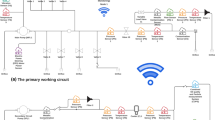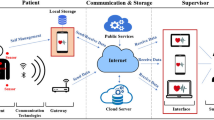Abstract
With various challenging areas as the focus in software development, statistical modelling for software source code tries to derive the knowledge hidden in various software artifacts including code and text and help building robust systems which are intelligent. Integrated Development Environment (IDE) is one area of focus in the domain. Since this provides platform for entire software development processes, it plays key role. In this chapter, study of intelligent IDEs is extended to IoT environment context. To begin with, we focus our study on understanding the IDEs and their capability. Exploration will focus on open-source IDE for mobile, and we look for better understanding the landscape so that we can extend the learning to the IoT world. In this work, building low cost IDE for mobile is focused open. Also, interestingly, exploration focuses on open-source components and possibility of putting them together. Then, in next part, we explore the IDE for Internet of things (IoT), with focus on open source ecosystem. In this review, we extend the exploration of IoT in to device management, data management, communication, intelligent data processing, security and privacy, and application deployment areas. This gives a greater insight in to the IoT world to extend the need of intelligent IDEs to IoT world. Then, to get the context of IDE in the machine learning context, we explore the topic of building optimal IDE for feature engineering which is one of the key phases in machine learning life cycle. Since machine learning projects are highly data-oriented eco system, learning of IDE and its insights in this area will provide rich insights in to the main theme of discussion which is intelligent IDE for IoT eco system.
Access this chapter
Tax calculation will be finalised at checkout
Purchases are for personal use only
Similar content being viewed by others
References
Eclipse, “Eclipse”. Available at https://www.eclipse.org. Visited 6/5/06.
Scratchbox. Scratchbox—Cross-Compilation Toolkit Project. Available at https://www.scratchbox.org. Visited 06/05/06.
Pydev. Python Development Environment. Available at https://Pydev.sourceforge.net/. Visited 7/5/06.
Järvensivu, J., Kosola, M., Kuusipalo, M., Reijula, P., & Mikkonen, K., Developing an open source integrated development environment for a mobile device. Institute of Software Systems, Tampere University of Technology, P.O. Box 553, FI-33101, Tampere.
Belli, L., Cirani, S., Davoli, L., Gorrieri, A., Mancin, M., & Picone, M. (2015). Design and deployment of an IoT application oriented testbed. IEEE Computer, 48, 32–40.
Gordon, A. D., Henzinger, T. A., Nori, A. V., & Rajamani, S. K., Probabilistic programming.
Fit IOT-LAB. Available online: https://www.iot-lab.info/. Accessed on June 18, 2018.
Sotres, P., Santana, J. R., Sanchez, L., Lanza, J., & Munoz, L. (2017). Practical lessons from the deployment and management of a smart city internet-of-things infrastructure: The SmartSantander testbed case. IEEE Access, 5, 14309–14322.
Sánchez, L., Gutiérrez, V., Galach, J. A., Sotres, P., Santana, J. R., Casanueva, J., et al. (2013). SmartSantander: Experimentation and service provision in the smart city. In Proceedings of the 16th International Symposium on Wireless Personal Multimedia Communications (WPMC) (pp. 1–6), Atlantic City, NJ, USA, June 24–27, 2013.
Eclipse Kapua. Available online: https://www.eclipse.org/Kapua/. Accessed on June 25, 2018.
Da Cruz, M. A. A., Rodrigues, J. J. P. C., Al-Muhtadi, J., Korotaev, V., & Albuquerque, V. H. C. (2018). A reference model for internet of things middleware. IEEE Internet Things Journal, 99, 871–883.
Esquiagola, J., Costa, L., Calcina, P., Fedrecheski, G., & Zuffo, M. (2017). Performance testing of an internet of things platform. In Proceedings of the 2nd International Conference on Internet of Things, Big Data and Security (pp. 309–314), Porto, Portugal, April 24–26, 2017.
Anderson, M. R., Cafarella, M., Jiang, Y., Wang, G., & Zhang, B., An integrated development environment for faster feature engineering.
Anderson, M., Antenucci, D., Bittorf, V., Burgess, M., Cafarella, M., Kumar, A., et al. (2013). Brainwash: A data system for feature engineering. In CIDR.
Dean, J., & Ghemawat, S. (2004). MapReduce: Simplified data processing on large clusters. In OSDI.
Biswas, J., Kureethara, J. V., Samanta, D., & Sandhya, M. (2020). Efficient algorithm for people management in an elevator. TEST Engineering & Management, 83. Publication issue: March–April 2020, ISSN: 0193-4120.
Samanta, D., Galety, M. G., Shivamurthaiah, M., & Kariyappala, S. (2020). A hybridization approach based semantic approach to the software engineering. TEST Engineering & Management, 83. Publication issue: March–April 2020, ISSN: 0193-4120.
Manral, S., Samanta, D., & Podder, S. K. (2020). Effective classroom activities on accounting using double entry system: The productive consequences. TEST Engineering & Management, 83. Publication Issue: March–April 2020, ISSN: 0193-4120.
A Khamparia,P K Singh,P Rani,Samanta, D,A Khanna, B Bhushan. (2020). An internet of health things driven deep learning framework for detection and classification of skin cancer using transfer learning. Transactions on Emerging Telecommunications Technologies. ISSN:2161-3915 2020.
Gurunath, R., & Samanta, D. (2020). Studies on encrypted secret data storage techniques analogous to steganography. International Journal of Advanced Science and Technology, 29(2), 3705–3711.
Li, Y. Q. (2018). An integrated platform for the internet of things based on an open source ecosystem. Future Internet, 10(11), 105. Received: September 21, 2018. Accepted: October 30, 2018. Published: October 31, 2018.
Roy, S., Kanti, M. M., Samanta, D., & Venkatanagaraju. (2020). Awareness with informatics on hypertension and effects on hemoglobin. International Journal of Advanced Science and Technology, 29(4), 423–433.
Samanta, D.Sivaram, M., Rashed, A., Boopathi, C..S., Amiri, IS., & Yupapin, P (2020). Distributed feedback laser (DFB) for signal power amplitude level. Journal of Optical Communication,doi: https://doi.org/10.1515/joc-2019-0252.
Gomathy, V., Padhy, N., Samanta, D., Sivaram, M., Jain, V., & Amiri, I. S. (2020). Malicious node detection using heterogeneous cluster based secure routing protocol (HCBS) in wireless adhoc network. Journal of Ambient Intelligence and Humanized Computing.
Thomas, B., Shwetha, P., Dey, P., Biswas, J., & Samanta, D. (2020). An efficient and holistic approach to reduce output and dependent parameters for multi-output learning. International Journal of Advanced Science and Technology, 29(4), 25–33.
Chatterjee, K., Samanta, D., & Biswas, J. (2020). Enhancement of education with wearable computing device. CSI Communications, 43(10). ISSN 0970-647X.
Anwar, Z., Banerjee, S., Eapen, N. G., & Samanta, D., A clinical study of hepatitis B. Journal of Critical Reviews JCR, 6(5), 81–84. https://doi.org/10.22159/jcr.06.05.13. E-ISSN: 2394-5125.
Kureethara, V., Biswas, J., Samanta, D., & Eapen, N. G., Balanced constrained partitioning of distinct objects. International Journal of Innovative Technology and Exploring Engineering. ISSN: 2278-3075 (Online).
Sivakumar, P., Nagaraju, R., Samanta, D., Sivaram, M., HindiaIraj, M. N., & Amiri, S., A novel free space communication system using nonlinear InGaAsP micro system resonators for enabling power-control toward smart cities. Wireless Networks—The Journal of Mobile Communication, Computation and Information. ISSN: 1022-0038 (Print), 1572-8196 (Online).
Samanta, D., & Podder, S. K. (2019). Level of green computing based management practices for digital revolution and new India. International Journal of Recent Technology and Engineering, 8(2). ISSN: 2277-3878.
Mahua, B., Podder, S. K., Shalini, R., & Samanta, D. (2019). Factors that influence sustainable education with respect to innovation and statistical science. International Journal of Recent Technology and Engineering, 7(5S2). ISSN: 2277-3878.
Praveen, B., Umarani, N., Anand, T., & Samanta, D. (2019). Cardinal digital image data fortification expending steganography. International Journal of Recent Technology and Engineering, 7(5S2). ISSN: 2277-3878.
Manu, M. K., Roy, S., & Samanta, D. (2018). Effects of liver cancer drugs on cellular energy metabolism in hepatocellular carcinoma cells. International Journal of Pharmaceutical Research, 10(3). ISSN: 0975-2366.
Paul, M., Sanyal, G., Samanta, D., Nguyen, G. N., & Le, D.-N., Admission control algorithm based-on effective bandwidth in V2I communication. IET Communications, 10. https://doi.org/10.1049/iet-com.2017.0825. Online ISSN 1751-8636.
Hall, M., Frank, E., Holmes, G., Pfahringer, B., Reutemann, P., & Witten, I. H. (2009). The WEKA data mining software: An update. SIGKDD Explorations Newsletter, 11(1):10–18.
Settles, B. (2009). Active learning literature survey. Computer Sciences Technical Report 1648, University of Wisconsin-Madison.
Zhang, C., Niu, F., Re, C., & Shavlik, J. W. (2012). Big data versus the crowd: Looking for relationships in all the right places. In ACL.
Bubeck, S., & Cesa-Bianchi, N. (2012). Regret analysis of stochastic and nonstochastic multi-armed bandit problems. Machine Learning, 5(1), 1–122.
Author information
Authors and Affiliations
Corresponding author
Editor information
Editors and Affiliations
Rights and permissions
Copyright information
© 2021 The Editor(s) (if applicable) and The Author(s), under exclusive license to Springer Nature Singapore Pte Ltd.
About this chapter
Cite this chapter
Althar, R.R., Samanta, D. (2021). Building Intelligent Integrated Development Environment for IoT in the Context of Statistical Modeling for Software Source Code. In: Kumar, R., Sharma, R., Pattnaik, P.K. (eds) Multimedia Technologies in the Internet of Things Environment. Studies in Big Data, vol 79. Springer, Singapore. https://doi.org/10.1007/978-981-15-7965-3_7
Download citation
DOI: https://doi.org/10.1007/978-981-15-7965-3_7
Published:
Publisher Name: Springer, Singapore
Print ISBN: 978-981-15-7964-6
Online ISBN: 978-981-15-7965-3
eBook Packages: Intelligent Technologies and RoboticsIntelligent Technologies and Robotics (R0)




